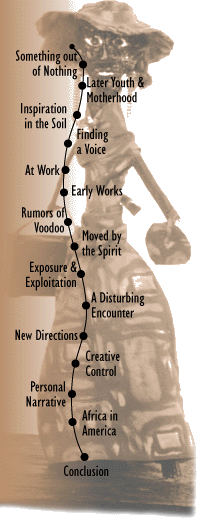Something Out of Nothing
Born Bessie Ruth White on October 11, 1929, in Dallas, Georgia, Harvey was the seventh of 13 children born to Homer and Rosie Mae White. Of her adverse circumstances, the artist once observed, "The story of my life would make Roots and The Color Purple look like a fairy tale. There was nothing. In the morning, you'd just get up, go looking for whatever you could find, and if you had one meal that day, then you'd made progress." To make matters worse, Harvey's mother was an alcoholic and her father died when she was a child. While drawing strength from her mother's strong Christian faith, the artist found additional comfort in her own ability to give shape to her visions using her hands and ordinary objects. "I was always finding ways of making something out of nothing when I was little. I'd find some old box and make us an old-timey car. I'd put two tin cans in front and two in back, and we'd sit in it and go off places. All kinds of places. I think it was God's way of making us happier children." This theme of escape would reappear prominently in her art some 50 years later.

It was also in childhood that Harvey began to notice the presence of vivid imagery in her mind, which would eventually become the wellspring of her art. In 1984 she recalled, "When I was a child I had these strange things I'd see and feel and now I'm putting them in wood." At the time, she assumed the visions were normal and apparently neither dismissed them nor attempted to give them physical form. Nonetheless, her active mental landscape provided a separate world in which she found welcome sanctuary from her troubles. Harvey also found inspiration and comfort in her natural surroundings. From early memories of nights spent on a mattress of pine needles, the artist maintained a close relationship with nature and was ever-attentive to its ebb and flow. She prayed aloud and talked to trees, birds and clouds, which she perceived as benevolent forces capable of nurturing those who took time to call upon them. "I came up without guidance, except for what the spirit that lived within me taught me. There was a lot of hurt, but I knew from the time I was a child that I had a friend in nature; the trees, the grass, and wind," Harvey recalled in 1994. These natural entities, especially trees, were seen by the artist as far more than just part of God's creation: "Trees is soul people to me, maybe not to other people, but I have watched trees when they pray and I've watched them shout and sometimes they give thanks slowly and quietly, they praise God."
